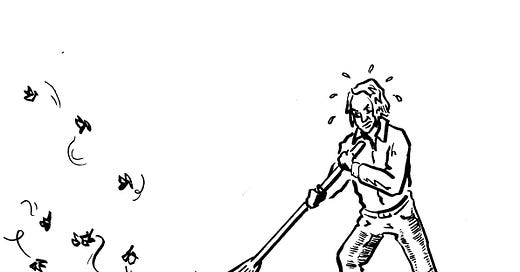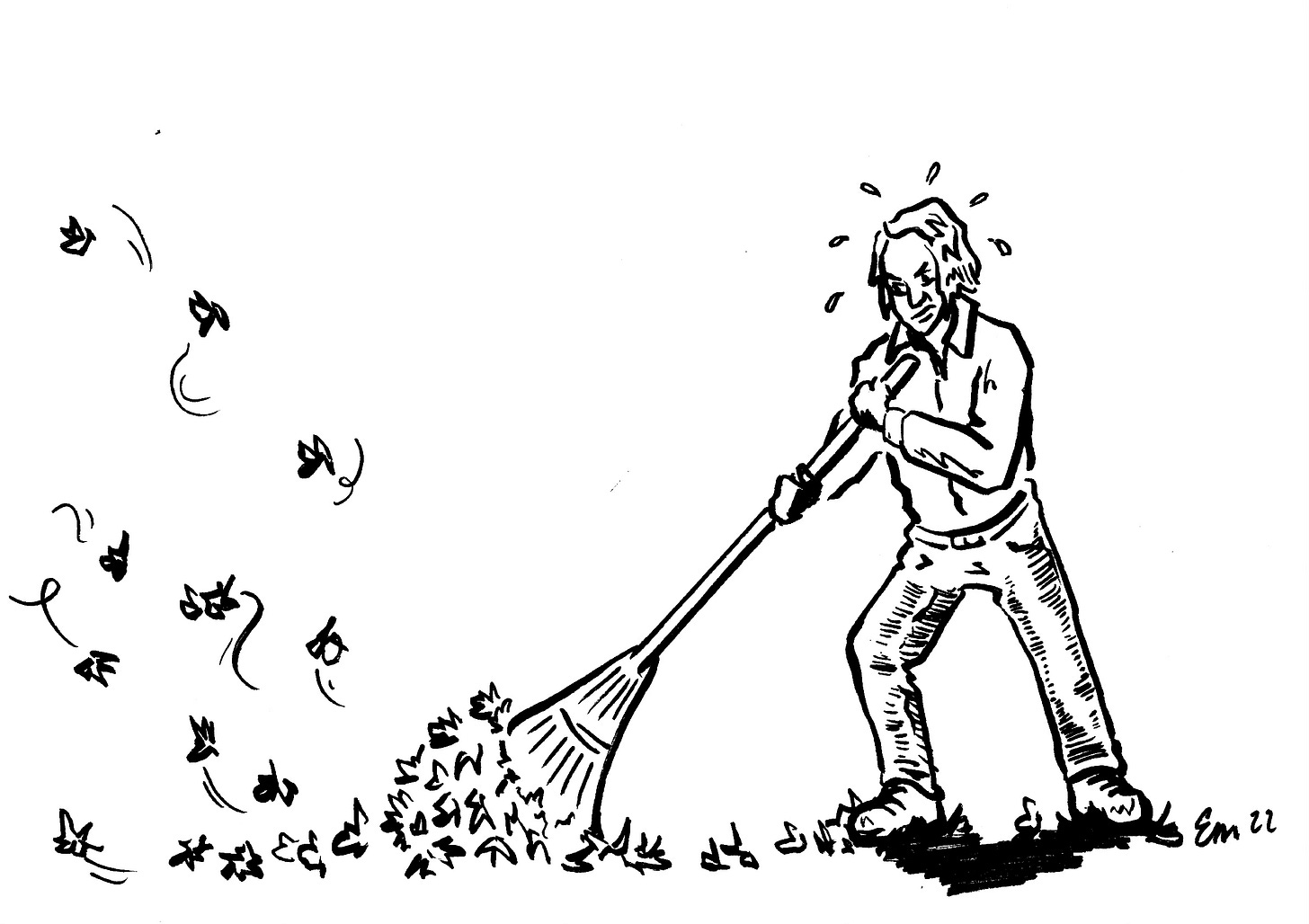Kurt Vonnegut said there are two types of writers: Swoopers, who dive in, get it all down, and then go back and painstakingly fix whatever doesn’t work; and Bashers, who go slowly, trying to get it right, one sentence at a time.
I’ve worked both ways. But, for longer pieces, I’m primarily a Leaf Raker—from the research phase to the final draft.
I discovered this when we lived in a house in the country with two large fields. One was so rocky it barely needed mowing. The other was larger and wide open; bordered on three sides by sugar maples, along with a few oaks and a beech or two that had snuck in while the maples weren’t looking.
The maple leaves began to fall in late summer. At first, I’d just watch as they collected in little clusters under the largest trees.
During one of those late summers, I began working on a large project—a documentary. My colleagues were more familiar with the subject than I was, so they began suggesting books and articles for me to read and sharing their preliminary ideas for the script. I’d listen, print out key emails and documents, pick up random books, read a few pages, and jot notes on the pads scattered around my office. After a few weeks, however, it was time to get serious. (I.e., I got a signed contract.)
The key to raking a large area is to create small piles and rake them together into increasingly larger piles. It sounds simple but there’s some strategy involved—where to place each pile on the field, how close they should be to each other, and how big they should be before starting a new one.
There are many ways to organize large projects. I’ve used most of them—starting with the index cards on which I wrote notes during Junior High School and organized in a small gray metal box with carefully labeled dividers. Since then, I’ve used multi-level outlines, multi-sized index cards, and multi-colored sticky notes arranged and rearranged on walls or whiteboards. Nowadays, many people use scrawled collections of boxes, arrows, doodles, and charts called “mind maps.” They don’t work for me. I’m trying to organize all that chaos in my brain, not turn it into a work of art.
Rakes come in a surprising number of sizes and materials. I prefer old-fashioned bamboo rakes. That’s what I used when I raked my parents’ lawn 50+ years ago, so they’re nostalgic as well as natural. Plastic ones are more practical—they tend to be wider but the leaves don’t come off as easily. Metal rakes are great for scratching every last leaf bit out of the grass, but that feels a little obsessively suburban.
As summer turned into fall, my fellow filmmakers increasingly inundated me with ideas, suggestions, advice, books, magazine articles, and quotations. Fearful of succumbing to information overload, I hurriedly began to collect them into more targeted folders, subfolders, and files, (I use a program called Scrivener to organize projects. It’s so good, Microsoft Word should slink away in shame and take its multiple menus and obscure shortcuts along with it.)
Just as I felt I was making progress, the leaves on the maples began to drop in earnest, joined now by the beeches. It was no longer enough to have a few small piles. I needed five, then six, then ten. A friend offered to lend me a leaf blower, but that seemed like a sacrilege. Another suggested I just mow them all. I tried that once. But it created a big mush of brown. Besides, I like raking.
The background information kept coming, but my basic organization held together pretty well. Occasionally, something simply didn’t fit so I created a new folder or threw the information into what my colleagues call an “icebox,” which is kind of like a teenager saying they want to date other people but aren’t ready to talk about it yet.
One of my favorite raking moments is when a strong puff of wind hits the leaves just right so a cluster floats up in the air and does a pirouette before falling back to earth.
By late September, I began to rake all the little piles of leaves into one big pile.
And, I began working on a draft of the script.
One night in late October, I woke up and heard a howling north wind. By morning, my carefully sorted piles had disintegrated into one inchoate mess.
As I began to write the script, I sat in on two long interviews with experts and received some preliminary feedback from colleagues, both of which made everything I’d written so far appear appear to be one big disorganized, incoherent jumble of sentences.
I’ve learned not to panic at times like this. You just have to take a deep breath, pick up your rake and get back to work.
The next draft can be rather grueling. But the situation may turn out to be less dire than it seemed: The general organization may not be a tear-down, just need some structural work; some of the good sentences may still work as is. By the third or fourth draft, you might even be able to do a little swooping and bashing.
But you can’t get overconfident. Most of the oak leaves won’t start falling for another month and even continue, often past the first snowfall, when they’ll scatter, rust-colored, across the pristine white.
Just when you thought everything was perfect.





Gratitude from an inveterate basher.
Hi David, Thanks for this. Critical time just as I am attempting to get in the rhythm of writing. Between this and what I think I recall Stephen King say, you have to just do it. Something. Just start the writing, or at least commit to sitting Zen-style until something shows up. Is that a thing?